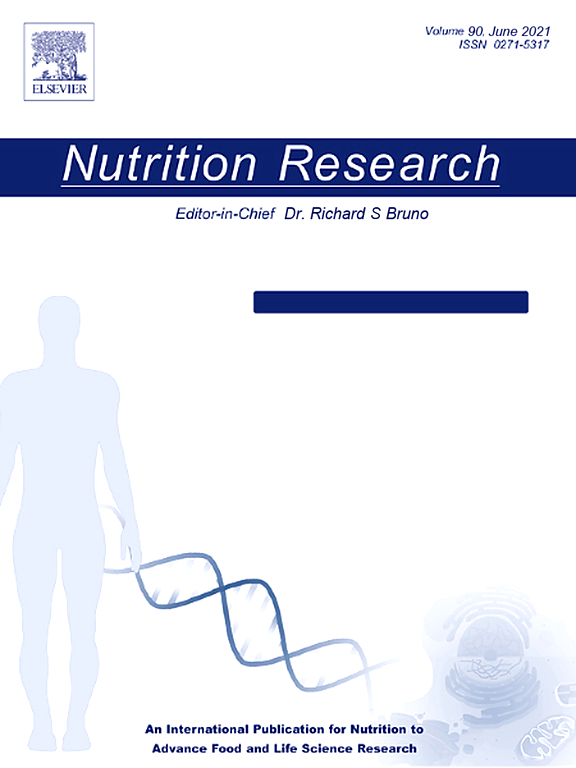A reflection-spectroscopy measured skin carotenoid score strongly correlates with plasma concentrations of all major dietary carotenoid species except for lycopene
IF 3.1
3区 医学
Q2 NUTRITION & DIETETICS
引用次数: 0
Abstract
Skin carotenoids can be measured non-invasively using spectroscopy methods to provide a biomarker of total dietary carotenoid and carotenoid-rich fruit and vegetable intake. However, the degree to which skin carotenoid biomarkers reflect intakes of specific carotenoids must be determined for specific devices. Previously, findings were mixed regarding the correlation between reflection spectroscopy (RS)-assessed skin carotenoids and individual plasma carotenoid concentrations. The current study expands on prior analyses to examine the cross-sectional associations between adult RS-assessed skin carotenoids and individual carotenoid species intakes and plasma concentrations, controlling for potential covariates. We hypothesized that RS-assessed skin carotenoid scores would strongly correlate with all major plasma carotenoid species other than lycopene. Cross-sectional data from 2 prior studies (n = 213 and n = 162) examining the validity and sensitivity of RS-assessed skin carotenoids as a biomarker of fruit and vegetable intake were used. Skin carotenoids were assessed using the Veggie Meter, which quantifies combined skin carotenoid concentrations. Plasma concentrations of α-carotene, β-carotene, β-cryptoxanthin, lycopene, and lutein and zeaxanthin were determined using high-performance liquid chromatography. Self-reported carotenoid intake was estimated from validated food frequency questionnaires. Skin carotenoid scores correlated moderately to strongly with individual plasma carotenoid species (Pearson's r = 0.52 to r = 0.78) except for lycopene (r = 0.04 to r = 0.07). Low correlations between skin carotenoid score and lycopene plasma concentrations and intake could be due to differential deposition, preferential oxidation/degradation, and/or device measurement bias. Validating skin carotenoid measurement techniques relative to other concentration biomarkers informs the interpretation of skin carotenoid biomarkers.

反射光谱测量的皮肤类胡萝卜素得分与除番茄红素外的所有主要膳食类胡萝卜素的血浆浓度密切相关。
皮肤类胡萝卜素可以使用光谱学方法无创测量,以提供总膳食类胡萝卜素和富含类胡萝卜素的水果和蔬菜摄入量的生物标志物。然而,皮肤类胡萝卜素生物标志物反映特定类胡萝卜素摄入量的程度必须针对特定设备确定。以前,关于反射光谱(RS)评估的皮肤类胡萝卜素和个体血浆类胡萝卜素浓度之间的相关性,研究结果是混合的。目前的研究扩展了先前的分析,以检查成人rs评估的皮肤类胡萝卜素和个体类胡萝卜素的摄入量和血浆浓度之间的横断面关联,控制潜在的协变量。我们假设rs评估的皮肤类胡萝卜素评分与除番茄红素外的所有主要血浆类胡萝卜素种类密切相关。本研究使用了先前两项研究(n = 213和n = 162)的横断面数据,以检验rs评估的皮肤类胡萝卜素作为水果和蔬菜摄入量生物标志物的有效性和敏感性。皮肤类胡萝卜素的评估使用蔬菜计,量化综合皮肤类胡萝卜素的浓度。采用高效液相色谱法测定血浆中α-胡萝卜素、β-胡萝卜素、β-隐黄质、番茄红素、叶黄素和玉米黄质的浓度。自我报告的类胡萝卜素摄入量是通过有效的食物频率问卷来估计的。除了番茄红素(r = 0.04 ~ r = 0.07)外,皮肤类胡萝卜素评分与血浆类胡萝卜素的种类有中等到强烈的相关性(Pearson’s r = 0.52 ~ r = 0.78)。皮肤类胡萝卜素评分与番茄红素血浆浓度和摄入量之间的低相关性可能是由于不同的沉积、优先氧化/降解和/或设备测量偏差。验证皮肤类胡萝卜素相对于其他浓度生物标志物的测量技术有助于解释皮肤类胡萝卜素生物标志物。
本文章由计算机程序翻译,如有差异,请以英文原文为准。
求助全文
约1分钟内获得全文
求助全文
来源期刊

Nutrition Research
医学-营养学
CiteScore
7.60
自引率
2.20%
发文量
107
审稿时长
58 days
期刊介绍:
Nutrition Research publishes original research articles, communications, and reviews on basic and applied nutrition. The mission of Nutrition Research is to serve as the journal for global communication of nutrition and life sciences research on diet and health. The field of nutrition sciences includes, but is not limited to, the study of nutrients during growth, reproduction, aging, health, and disease.
Articles covering basic and applied research on all aspects of nutrition sciences are encouraged, including: nutritional biochemistry and metabolism; metabolomics, nutrient gene interactions; nutrient requirements for health; nutrition and disease; digestion and absorption; nutritional anthropology; epidemiology; the influence of socioeconomic and cultural factors on nutrition of the individual and the community; the impact of nutrient intake on disease response and behavior; the consequences of nutritional deficiency on growth and development, endocrine and nervous systems, and immunity; nutrition and gut microbiota; food intolerance and allergy; nutrient drug interactions; nutrition and aging; nutrition and cancer; obesity; diabetes; and intervention programs.
 求助内容:
求助内容: 应助结果提醒方式:
应助结果提醒方式:


